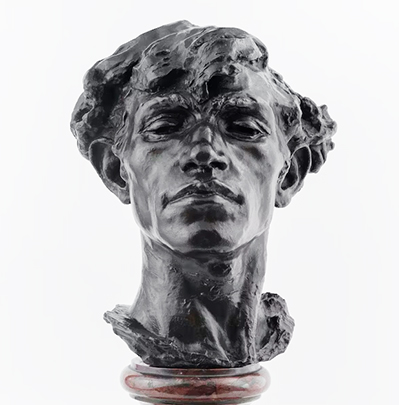카미유 클로델 (Camille Claudel) 전시회@시카고아트인스티튜트(10/7-2/19. 2024)
Camille Claudel
Oct 7, 2023–Feb 19, 2024
Chicago Art Institute

Camille Claudel, Giganti or Head of a Brigand, modeled about 1885, cast 1885-before 1892, Palais des Beaux-Arts, Lille
The trailblazing French sculptor Camille Claudel (1864–1943) defied the social expectations of her time to pursue original and powerful explorations of the human form.
During that period, few women achieved celebrity in the field of sculpture, which, unlike painting or drawing, continued to be a largely male enterprise. Densely material, largely reliant on nude models, physically demanding, and bound up in male-dominated and politicized systems of state patronage, sculpture was not considered a polite art, and Claudel’s ambitions in that arena were transgressive. Her work prompted the critic Octave Mirbeau to famously exclaim, “We are in the presence of something unique, a revolt of nature: a woman genius.”
A bronze sculpture of a kneeling nude female figure. She leans forward with both arms reaching up in diagonal, and her head tilts to the side, pleading. One knee is slightly ahead of the other as if walking on her knees.
The Implorer (large model), modeled about 1898–99, cast about 1905
Claudel’s biography—her passionate and complicated relationship with her teacher, Auguste Rodin, and her forced confinement in a psychiatric institution for the final 30 years of her life—is popularly known today, but her forward-thinking artworks have received less attention in the United States. This exhibition is the first comprehensive display of Claudel’s work in the United States in over 20 years and marks the 130th anniversary of the first public presentation of her sculpture in this country—at the 1893 World’s Columbian Exposition in Chicago. Featuring some 60 sculptures from more than 30 institutional and private lenders, the presentation gathers her key compositions—including Young Roman, recently acquired by the Art Institute—showcasing her remarkable technical ability and innovative creations across multiple genres and materials. These range from portraiture to large-scale allegories to scenes inspired by her keen observation of everyday life, and are made in terracotta, plaster, bronze, and stone.
Claudel’s sculptures contend with universal themes of love, loss, passion, and the intimacy of daily experience; they embody the artist’s uncompromising pursuit of stylistic and professional independence. Her genius and sensibility are so thoroughly modern that her works continue to resonate, perhaps even more loudly today than during her tumultuous life.
A sculpture carved out of a light-green stone with veins of orange and white comprises four seated nude female figures facing each other in a circle, leaning in as if in deep conversation. Two partial walls meet in a corner behind them, framing the scene.
Curated by Emerson Bowyer at the Art Institute and Anne-Lise Desmas at the J. Paul Getty Museum, the exhibition is accompanied by a scholarly catalogue with essays by specialists on Claudel, newly translated letters written by the sculptor, and a contribution by contemporary artist Kiki Smith.
https://www.artic.edu





